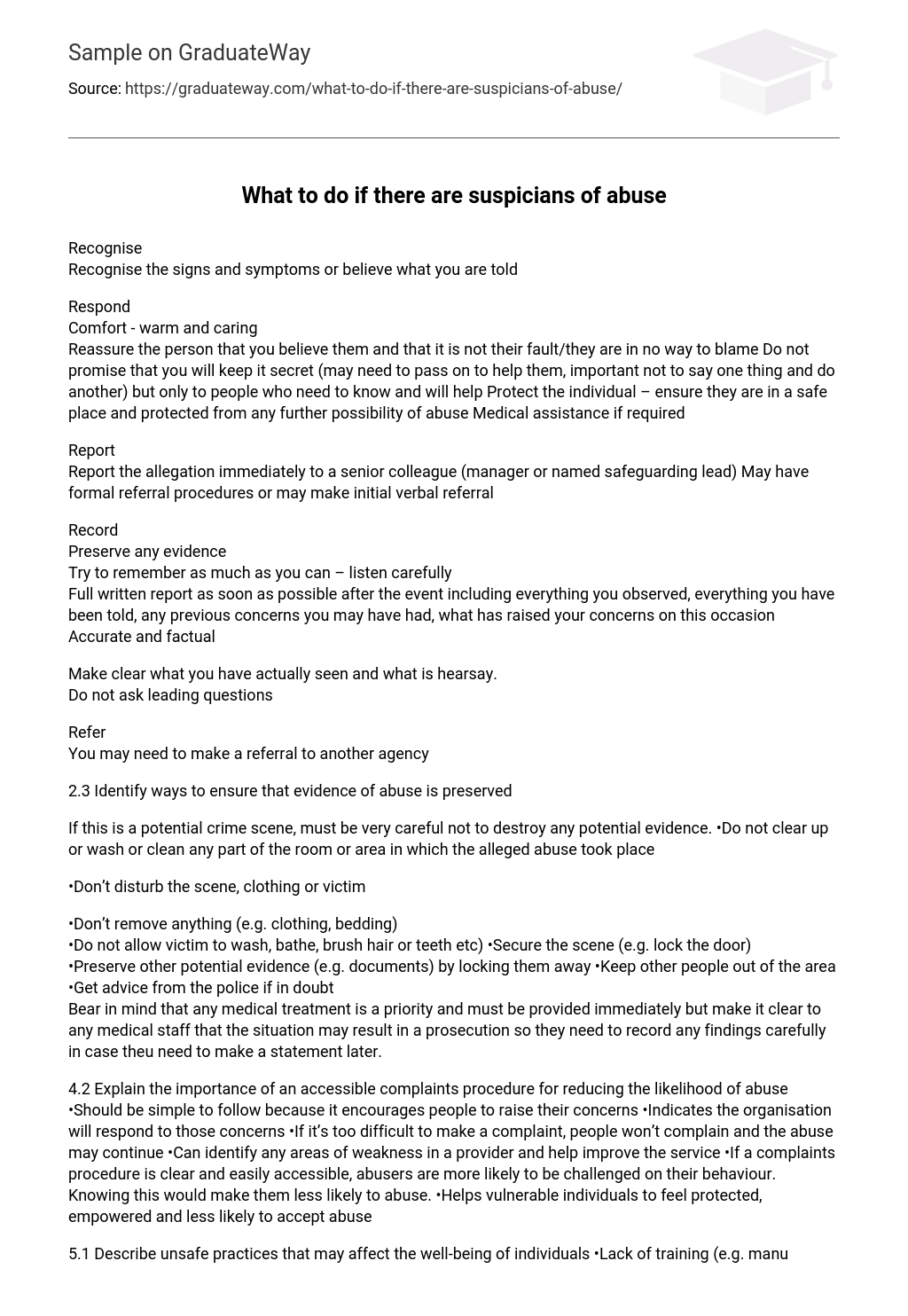Recognise
Recognise the signs and symptoms or believe what you are told
Respond
Comfort – warm and caring
Reassure the person that you believe them and that it is not their fault/they are in no way to blame Do not promise that you will keep it secret (may need to pass on to help them, important not to say one thing and do another) but only to people who need to know and will help Protect the individual – ensure they are in a safe place and protected from any further possibility of abuse Medical assistance if required
Report
Report the allegation immediately to a senior colleague (manager or named safeguarding lead) May have formal referral procedures or may make initial verbal referral
Record
Preserve any evidence
Try to remember as much as you can – listen carefully
Full written report as soon as possible after the event including everything you observed, everything you have been told, any previous concerns you may have had, what has raised your concerns on this occasion Accurate and factual
Make clear what you have actually seen and what is hearsay.
Do not ask leading questions
Refer
You may need to make a referral to another agency
2.3 Identify ways to ensure that evidence of abuse is preserved
If this is a potential crime scene, must be very careful not to destroy any potential evidence. •Do not clear up or wash or clean any part of the room or area in which the alleged abuse took place
•Don’t disturb the scene, clothing or victim
•Don’t remove anything (e.g. clothing, bedding)
•Do not allow victim to wash, bathe, brush hair or teeth etc) •Secure the scene (e.g. lock the door)
•Preserve other potential evidence (e.g. documents) by locking them away •Keep other people out of the area
•Get advice from the police if in doubt
Bear in mind that any medical treatment is a priority and must be provided immediately but make it clear to any medical staff that the situation may result in a prosecution so they need to record any findings carefully in case theu need to make a statement later.
4.2 Explain the importance of an accessible complaints procedure for reducing the likelihood of abuse •Should be simple to follow because it encourages people to raise their concerns •Indicates the organisation will respond to those concerns •If it’s too difficult to make a complaint, people won’t complain and the abuse may continue •Can identify any areas of weakness in a provider and help improve the service •If a complaints procedure is clear and easily accessible, abusers are more likely to be challenged on their behaviour. Knowing this would make them less likely to abuse. •Helps vulnerable individuals to feel protected, empowered and less likely to accept abuse
5.1 Describe unsafe practices that may affect the well-being of individuals •Lack of training (e.g. manual handling, personal care, eating and drinking) •Not observing confidentiality
•Not following infection control procedures
•Confusion over prescribing and administering medication
•Fire evacuation procedures
•Failure to comply with regulations
5.2 Explain the actions to take if unsafe practices have been identified Tell their manager or named safeguarding person.
5.3 Describe the actions to take if suspected abuse or unsafe practices have been reported but nothing has been done about it Record any information carefully (factual, time and date etc) Keep moving through the management chain. If no one in your organisation responds, contact CQC or IW Council Safeguarding Adults Board (google and find out how to contact) If it is a criminal offence (e.g. theft, fraud, physical or sexual abuse) refer the matter to the police Public Concern at Work is a national organisation that provides information legal advice to people who are concerned about malpractice at work. Free and confidential advice. (www.pcaw.co.uk) May be very difficult to pass information on – this is known as ‘whistleblowing’ Public Interest Disclosure Act (1998) protects whistleblowers and ensures you cannot be victimised by your employer for reporting abuse or any other illegal acts So long as you have a ‘reasonable belief’ that one of the following is taking, has taken or may take place, you are protected by law: •A criminal offence
•Breach of a legal obligation
•Miscarriage of justice
•Danger to the health and safety of any person
•Damage to the environment
•Deliberate covering up of information tending to show any of the above





